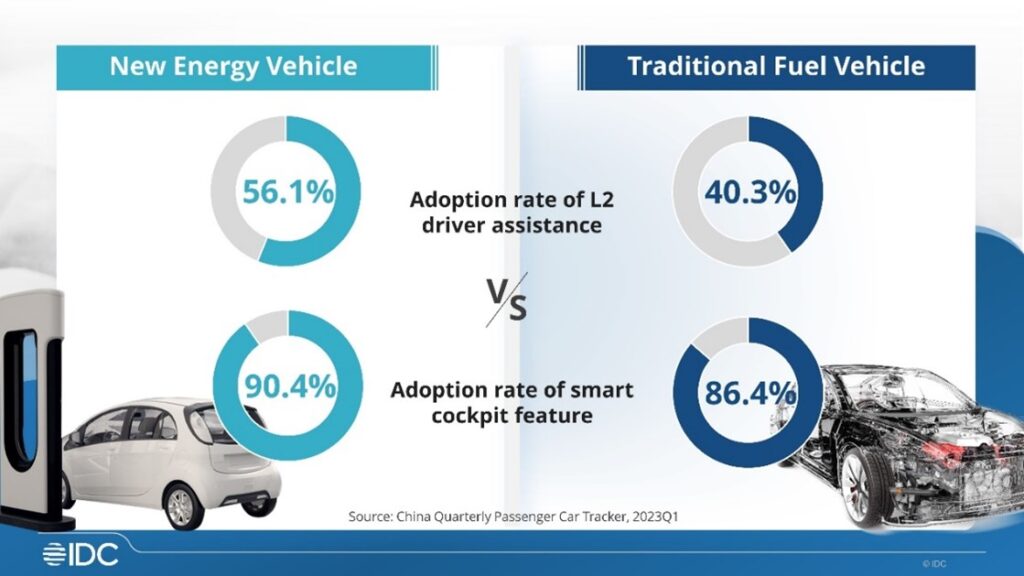The China New Energy Vehicle (NEV) market has soared over the past two years and has become the most promising segment in the China passenger vehicle market. Amid a new round of industrial chain adjustments and upgrades centered around NEVs, Internet of Vehicles (IoV) and intelligentization, o rthe addition of AI to a system, NEVs have become new focal points among suppliers and car manufacturers.
The noteworthy emerging trends on China’s NEV include:
- The realization of smart cockpits and smart driving functions as the demand for new energy passenger vehicle accelerates.
- Autonomous driving and smart cockpits have become popular areas for IoV market development.
- Rapid growth in the automotive cloud market given it is the infrastructure behind IoVs.
NEVs Drive the Intelligent Transformation of China Automotive Industry
The China NEV market size bucked the overall market fluctuations in the first quarter of 2023. Not only did the emerging brands maintain their overall development momentum, but traditional car manufacturers achieved phased progress in electrification.
The NEV market has grown over the past few years with increasing penetration. IDC predicts that the penetration rate of NEVs in the China passenger vehicle market will exceed 30% in 2023.

According to Bull Wang, Research Manager at IDC China, the electrification and intelligentization of passenger vehicles is a vital indicator of the development stage of the entire automotive market. Electrification makes the underlying architecture of vehicles more suitable for the realization of smart driving and smart cockpits technologies, the two pillars of vehicle intelligentization.
Research shows that autonomous driving technology is applied in the passenger vehicle market primarily in the form of assisted driving functions, especially for vehicles in the RMB 200,000–400,000 price segment. In terms of smart cockpits, breakthroughs have been made continuously in the dimensions of interaction between vehicles and users, expanding the use cases of cockpits.
In recent years, the industrial upgrading of IoV capabilities is an important support and driving force behind the rapid realization and development of smart driving and smart cockpit technologies.
Vehicle Market Shows the Trend of Electrification, Intelligentization, Networking, and Sharing
A car manufacturers’ launch of many functions is inseparable from the overall upgrading of upstream technologies and product systems in the automotive industry. The vendor led IoV market has formed as an organic combination of technology products for vehicles, roads, communications, cloud infrastructure and platforms, security, services, and solutions. It is now evolving toward electrification, intelligentization, networking, and sharing, among which electrification has been preliminarily completed. Intelligentization and networking are the current market hotspots, and sharing is an important trend in the future development.
Catherine Hong, Senior Research Analyst at IDC China, noted that IoV is an important direction for the integrated application of car manufacturing with software and communications.
With the continuous penetration of assisted driving functions, high-level autonomous driving products have become the mainstream direction with suppliers’ developments focused on technology upgrading and mass production.
Automotive Cloud Will Achieve a Compound Annual Growth Rate (CAGR) of 53.6% Over the Next Five Years
Automotive cloud refers to cloud computing infrastructure*, platforms, and use case solutions to meet the digitization and intelligent transformation of the automotive industry. This includes automotive industry suppliers, main engine manufacturers, and industry users of intelligent vehicles.
IDC predicts that the China automotive cloud market will continue to hit new highs in its growth, exceeding RMB 60 billion in 2027, at a five-year CAGR of 53.6%.
Yang Yang, Research Manager at IDC China, emphasized that the intelligent networking of vehicles has redefined the relationship between cloud and industry. The cloud is the production system, data and algorithms are competitive advantages, and software redefines products and services.
IDC Analyst Viewpoint
Looking ahead, with the further popularization of new energy vehicles, the rapid development of new technologies such as intelligentization, networking and autonomous driving, software-defined vehicles will drive the continuous transformation and upgrading of the automotive industry.
This will also reshape the vehicle industrial chain, leading to a new market competition landscape. How enterprises in the industrial chain will leverage their capabilities, make courageous transformations and seize market opportunities will become the top priority for automotive industry players.
Read more about IDC’s China research related to the smart vehicles and gain insights into future trends in the automotive market.
*Cloud computing infrastructure includes public cloud infrastructure services and private cloud infrastructure construction; cloud solutions include platforms and application solutions hosted on various types of cloud infrastructure.




